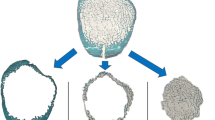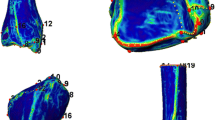Abstract
A detailed analysis of differences in skeletal shape among many individuals is expected to reveal the mechanical significance behind various morphological features. To confirm the distribution of the cortical bone region in cross sections, the relative position of the central mass distribution (CMD) of the cortical bone region to the CMD of the entire cross section was examined. A total of 90 right human femoral skeletons were examined using clinical multi-slice computed tomography. For nine cross sections of each femur, we determined the CMD of the whole area, including both cortical bone and medullary areas, as CMD-W, and that of the cortical bone region in the same cross section as CMD-C, and they were compared. The medial and anterior portion of the cortex was relatively thick just below the lesser trochanter. The posterior cortical bone tended to be relatively thick in the region from the center to the distal part of the diaphysis. Females had a significantly more medially deviated CMD than males throughout the entire diaphysis. These results suggest that femurs with advanced cortical bone thinning tend to have a concentration of cortical bone in their medial portion. CMD-C was located farther from the diaphysis axis as the degree of medial bending increased. Conversely, the greater the lateral bending of the diaphysis, the closer CMD-C was to the diaphysis axis. As the amount of bone decreases with age, self-adjustment could occur so that the cortical bone's critical area remains to prevent a decrease in mechanical strength.








Similar content being viewed by others
References
Alswat K (2017) Gender disparities in osteoporosis. J Clin Med Res 9:382–387
Birkhold AI, Razi H, Duda GN, Weinkamer R, Checa S, Willie BM (2016) The periosteal bone surface is less mechano-responsive than the endocortical. Sci Rep 6:1–11
Christopher R, Brigitte H, Erik T (2006) Who’s afraid of the big bad Wolff?: “Wolff’s” Law and bone functional adaptation. Am J Phys Anthropol 129:484–98
Endo D, Ogami-Takamura K, Imamura T et al (2020) Reduced cortical bone thickness increases stress and strain in the female femoral diaphysis analyzed by a CT-based finite element method: implications for the anatomical background of fatigue fracture of the femur. Bone Rep 13:100733
Feik SA, Thomas CDL, Clement JG (1996) Age trends in remodeling of the femoral midshaft differ between the sexes. J Orthop Res 14:590–597
Forwood MR (2001) Mechanical effects on the skeleton: are there clinical implications? Osteoporos Int 12:77–83
Frost HM (1997) On our age-related bone loss: insights from a new paradigm. JBMR 12:1539–1546
Frost HM (2003) Bone’s mechanostat: a 2003 update. Anat Rec Part A Discov Mol Cell Evol Biol 275:1081–1101
Galea GL, Hannuna S, Meakin LB et al (2015) Quantification of alterations in cortical bone geometry using site specificity software in mouse models of aging and the responses to ovariectomy and altered loading. Front Endocrinol (lausanne) 6:1–11
Gosman JH, Hubbell ZR, Shaw CN, Ryan TM (2013) Development of cortical bone geometry in the human femoral and tibial diaphysis. Anat Rec 296:774–787
Holcombe SA, Hwang E, Derstine BA, Wang SC (2018) Measuring rib cortical bone thickness and cross section from CT. Med Image Anal 49:27–34
Huiskes R (2000) If bone is the answer, then what is the question ? J Anat 197(Pt 2):145–156
Humbert L, Hazrati Marangalou J, Del Río Barquero LM et al (2016) Technical Note: cortical thickness and density estimation from clinical CT using a prior thickness-density relationship. Med Phys 43:1945–1954
Imamura T, Tsurumoto T, Saiki K et al (2019) Morphological profile of atypical femoral fractures: age-related changes to the cross-sectional geometry of the diaphysis. J Anat 235:892–902
Imamura T, Ogami-Takamura K, Saiki K et al (2021) Morphological divergence in the curvature of human femoral diaphyses: tracing the central mass distributions of cross-sections. J Anat 239:46–58
Ito M, Wakao N, Hida T et al (2010) Analysis of hip geometry by clinical CT for the assessment of hip fracture risk in elderly Japanese women. Bone 46:453–457
Ito M, Nakata T, Nishida A, Uetani M (2011) Age-related changes in bone density, geometry and biomechanical properties of the proximal femur: CT-based 3D hip structure analysis in normal postmenopausal women. Bone 48:627–630
Jeanson AL, Santos F, Dupej J et al (2018) Sex-specific functional adaptation of the femoral diaphysis to body composition. Am J Hum Biol 30:e23123
Khaled A (2017) Gender disparities in osteoporosis. J Clin Med Res 9:382–387
MacIntosh AA, Davies TG, Ryan TM et al (2013) Periosteal versus true cross-sectional geometry: A comparison along humeral, femoral, and tibial diaphyses. Am J Phys Anthropol 150:442–452
Miller CJ, Trichilo S, Pickering E et al (2021) Cortical thickness adaptive response to mechanical loading depends on periosteal position and varies linearly with loading magnitude. Front Bioeng Biotechnol 9:1–10
Morin SN, Wall M, Belzile EL et al (2016) Assessment of femur geometrical parameters using EOSTM imaging technology in patients with atypical femur fractures; preliminary results. Bone 83:184–189
O’Neill MC, Ruff CB (2004) Estimating human long bone cross-sectional geometric properties: A comparison of noninvasive methods. J Hum Evol 47:221–235
Pearson OM, Lieberman DE (2004) The aging of Wolff’s “law”: ontogeny and responses to mechanical loading in cortical bone. Yearb Phys Anthropol 47:63–99
Poole KES, Treece GM, Mayhew PM et al (2012) Cortical thickness mapping to identify focal osteoporosis in patients with hip fracture. PLoS ONE 7:e38466
Ramchand SK (2018) The influence of cortical porosity on the strength of bone during growth and advancing age. Curr Osteoporos Rep 16:561–572
Ruff C, Holt B, Trinkaus E (2004) Who’s afraid of the Big Bad Wolff? : “Wolff’s Law” and bone functional adaptation. Am J Phys Anthropol 129:80–83
Russo CR, Lauretani F, Seeman E et al (2006) Structural adaptations to bone loss in aging men and women. Bone 38:112–118
Shin WC, Moon NH, Jang JH et al (2017) Anterolateral femoral bowing and loss of thigh muscle are associated with occurrence of atypical femoral fracture: Effect of failed tension band mechanism in mid-thigh. J Orthop Sci 22:99–104
Someya K (2020) Age- and sex-related characteristics in cortical thickness of femoral.pdf. J Bone Miner Metab 38:533–543
Treece GM, Gee AH (2015) Independent measurement of femoral cortical thickness and cortical bone density using clinical CT. Med Image Anal 20:249–264
Treece GM, Gee AH, Mayhew PM, Poole KES (2010) High resolution cortical bone thickness measurement from clinical CT data. Med Image Anal 14:276–290
Treece GM, Poole KES, Gee AH (2012) Imaging the femoral cortex: thickness, density and mass from clinical CT. Med Image Anal 16:952–965
Trinkaus E (1997) Appendicular robusticity and the paleobiology of modern human emergence. Proc Natl Acad Sci USA 94:13367–13373
Trinkaus E, Ruff CB (1999) Diaphyseal cross-sectional geometry of Near Eastern Middle Palaeolithic humans: the Tibia. J Archaeol Sci 26:1289–1300
Troy KL (2020) Bone adaptation in adult women is related to loading dose. J Bone Min Res 35:1300–1312
Turner CH (1998) Three rules for bone adaptation to mechanical stimuli. Bone 23:399–407
Wolff J (1986) The law of bone remodelling (trans: Maquet P, Furlong R). Springer, New York
Yoo H, Cho Y, Park Y, Ha S (2017) Lateral femoral bowing and the location of atypical femoral fractures. Hip Pelvis 29:127
Zebaze RMD (2010) Intracortical remodelling and porosity in the distal radius and post-mortem femurs of women: a cross-sectional study. Lancet 375:1729–1736
Acknowledgements
The authors sincerely thank those who donated their bodies to science so that anatomical research could be performed. Results from such research can potentially increase mankind's overall knowledge that can then improve patient care. Therefore, these donors and their families deserve our highest gratitude.
Author information
Authors and Affiliations
Corresponding author
Ethics declarations
Conflict of interest
There is no conflict of interest to be disclosed.
Additional information
Publisher's Note
Springer Nature remains neutral with regard to jurisdictional claims in published maps and institutional affiliations.
Rights and permissions
About this article
Cite this article
Tsurumoto, T., Endo, D., Saiki, K. et al. Cross-sectional geometry of the femoral diaphyseal cortical bones: analysis of central mass distribution. Anat Sci Int 98, 77–88 (2023). https://doi.org/10.1007/s12565-022-00676-5
Received:
Accepted:
Published:
Issue Date:
DOI: https://doi.org/10.1007/s12565-022-00676-5




